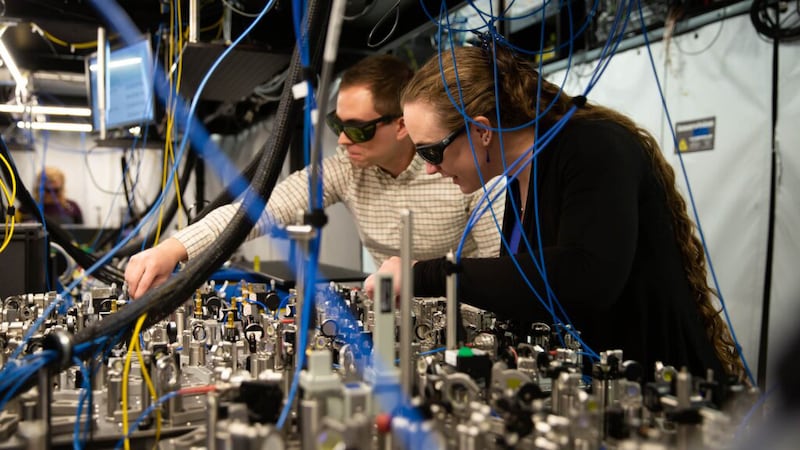Microsoft and Quantinuum have announced new technology designed to minimise inaccuracies associated with quantum computing algorithms.
The invention aims to boost the reliability of quantum computing, which is driving many new discoveries in health care, energy, environmental systems, smart materials, artificial intelligence, financial modelling, climate change, pharmaceutical research and cyber security.
Microsoft said the new technology is built on the “most reliable logical qubits on record”.
Just as a binary bit is the basic unit of information in traditional computing, a qubit is the basic unit of information in quantum computing.
The Redmond-based multinational corporation said it aims to release the new technology to its cloud computing customers in the coming months.
Quantum computing represents a massive acceleration in computing speed and performance.
Here The National looks at the intricacies of the new technology and explores its development and potential uses.
Making quantum computing less 'noisy'
While developing the new technology, the research team used Microsoft’s qubit-virtualisation system and Quantinuum’s hardware. They performed more than 14,000 individual experiments without a single error, the companies said in a statement.
The new breakthrough also permitted the team to verify the reliable qubits and amend any errors they encountered without destroying them.
Microsoft said the new innovation has advanced quantum computing beyond the traditionally dubbed Noisy Intermediate-Scale Quantum (NISQ) level to a more resilient and error-free stage.
It was called “noisy: because even a minor change in the environment can significantly increase the randomness within the system.
“This is a crucial milestone on our path to building a hybrid supercomputing system that can transform research and innovation across many industries,” said Jason Zander, Microsoft's executive vice president for strategic mission and technologies.
“It is made possible by the collective advancement of quantum hardware, qubit virtualisation and correction, and hybrid applications that take advantage of the best of AI and supercomputing,” he added.
Solving the scalability challenge
According to researchers, one of the key challenges of quantum computing is scalability. It lacks the skill to increase the number and quality of qubits in a system without compromising their performance and reliability.
However, the new technology promises scaled quantum computers that would come with an ability to simulate the interactions of millions of molecules and atoms at a level beyond the reach of traditional computers.
But quantum computing is just one layer for driving these breakthrough insights, industry experts said.
Researchers require access to appropriate tools at each stage of their discovery process to effectively address every aspect of their scientific challenge and generate insights where they are most impactful.
“This is what we built … empowering organisations to transform research and development with capabilities, including screening massive data sets with AI, narrowing down options with high-performance computing or improving model accuracy with the power of scaled quantum computing in the future,” Mr Zander said.
How does quantum computing work?
Quantum computing uses the principles of quantum physics, which govern the behaviour of particles at the atomic and subatomic levels, to tackle challenges that classical computers are unable to solve.
Quantum computing has the potential to, for example, model how chemical reactions take place, potentially eliminating the need to carry out reactions in a laboratory to develop drugs.
Unlike traditional computers, which encode information as either a zero or a one, quantum computers use qubits, which can exist in multiple states simultaneously, presenting a disruptive shift in data storage and processing capabilities.
Currently some of the world’s biggest technology firms are working with computers with a capacity of about 100 qubits, but to tackle the biggest problems, machines with 100,000 or one million qubits may be required.
How big is the market?
The quantum computing market size is projected to top $6.5 billion by 2030 from $928.8 million last year, expanding at a compound annual rate of 32.1 per cent, according to researcher Fortune Business Insights.
The world's biggest economies, including the US, Russia, China and Japan, as well as technology majors such as IBM, Alibaba, Google and Microsoft, are all investing heavily in the field. Companies such as Visa, JP Morgan and Volkswagen are also experimenting with early-stage quantum technology.
In late 2019, Google announced that it had achieved “quantum supremacy”, meaning its quantum computer became the first to solve a calculation in less than four minutes that would have taken the world’s most powerful supercomputer 10,000 years to complete.
The company also said in 2021 that it plans to build a commercial-grade quantum computer by 2029 that can perform error-free complex calculations in tiny fractions of a second.







